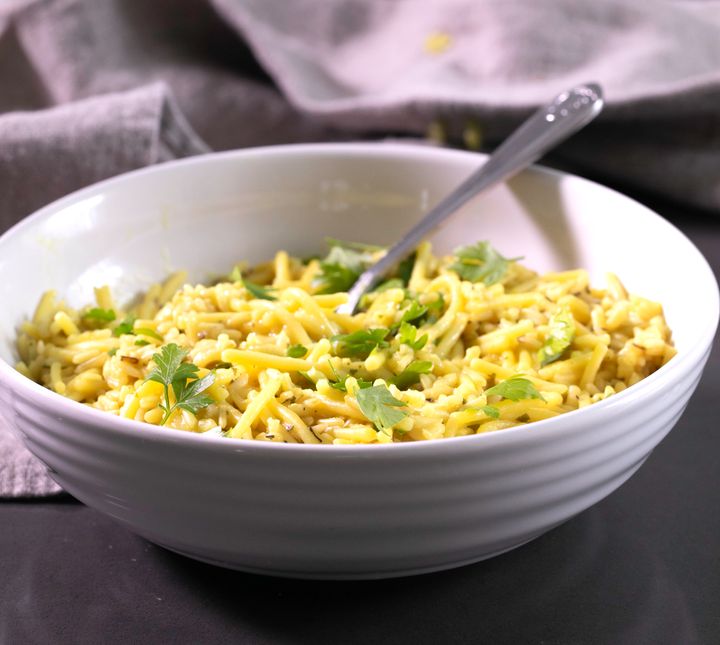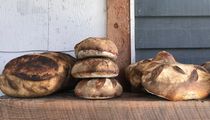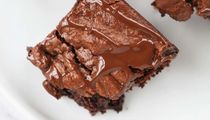If you eat gluten-free, you know how overwhelming, confusing and time-consuming it can feel.
We asked a team of experts ― including a top gluten-free registered dietician, a researcher, a doctor and cookbook authors ― what they really eat. Their insights offer simple suggestions for how to overcome the daily challenges of eating gluten-free.
Remember, eating is personal, so always do it your way.
If you’re following a gluten-free diet, you’re lacking whole grains. Here’s how to substitute for them.
Eating gluten-free can lead to a deficiency of whole grains and put your cardiac health at risk, according to a 2017 heart health study published by British Medical Journal. It’s imperative to find creative alternatives to whole wheat in your diet. What do the experts reach for?
Oats
A great source of whole grains and fiber, oats help keep the gut healthy, too. Alessio Fasano, author of Gluten Freedom and founder of the Center for Celiac Research, said that certified gluten-free oats are tolerated by 95 percent of those with celiac disease.
Tiffany Hinton, a blogger at Gluten-Free Mom Certified and author of several cookbooks, said she makes fiber-filled steel-cut oats and mixed berry salad with chia seeds in the morning for herself and her three young girls.
As a busy new mom, Lori Welstead, a registered dietician at the University of Chicago Celiac Disease Center, prepares overnight oats so breakfast is ready to grab and go.
Dr. Sheila Crowe, director of UC San Diego’s Celiac Disease Clinic, eats oatmeal with nuts to include healthy fats.
Whole grain bread
Bread containing sorghum, millet and teff provide gluten-free whole grain health. Welstead recommends Little Northern Bakehouse’s Millet & Chia Bread. It contains 3 g of fiber, toasts up crunchy and is great for sandwiches. The company makes a variety of loaves and buns with ancient and whole grains.
Quinoa
A favorite side for Crowe is cooked quinoa sautéed with multicolored peppers, spinach and onions.
Nicole Hunn, Gluten-Free On A Shoestring blogger and cookbook author, admits she doesn’t like quinoa’s texture, but has created a killer quinoa chocolate cake recipe.

Rice is gluten-free, but contains trace amounts of arsenic. Here’s what to eat instead.
Many prepackaged gluten-free products made with rice flour contain some inorganic arsenic. In 2015, Dr. Brian Jackson from the Trace Element Analysis Core Laboratory at Dartmouth worked with Tricia Thompson of the Gluten-Free Watchdog to lead extensive testing of arsenic in rice.
Based on the findings, Thompson told HuffPost, “I am convinced that inorganic arsenic intake among the gluten-free community is a serious concern and it deserves our attention.”
Thompson found the nastiest culprits in rice bran, rice syrup and rice milk. She recommends avoiding or reducing products that contain these ingredients. How do the experts find the right balance?
Try a variety of sides
Welstead looks to potatoes, quinoa and polenta as sides instead of rice. When choosing pasta, she likes zoodles and bean or lentil varieties that add fiber.
Thompson admits that she eats rice as a comfort food with dinner twice a week. To provide a range of grains, she chooses pasta made with corn and quinoa and avoids most prepackaged foods. She emphasizes that this choice works best for her, and isn’t right for everyone.
When baking with alternative flours, read the label carefully
Most baking mixes and prepackaged flours use rice flour as a base, so the experts bake from scratch.
Welstead and Crowe use alternatives including coconut and almond flours. Hunn, who bakes constantly for her blog and cookbooks, makes a lot of recipes with oats and oat flour.
A little planning goes a long way.
We asked experts for their easy meal suggestions and tips for approaching meal plans.
Instead of weekly planning, Hunn relies on a well-stocked pantry filled with staples to feed her active kids. She said, “People think because of my job, I have dinner in the bag, but the truth is, I’m scrambling to make dinner just like everyone else.” One of her family’s favorite go-to meals is her homemade “rice-a-roni.” “I prep half way to save time,” she said. Before the kids get home, she cuts up boneless, skinless chicken so it’s ready to cook, and her pantry always has the pre-mixed base on hand. The whole meal cooks in one pan and is ready in 30 minutes.
As a celiac who suffered with health problems for years, Hinton found healing though whole foods and is committed eating 6-9 cups of greens a day. Pre-planning gives her peace of mind. Since jarred salads are a mainstay, “prepping the salad jars and berry salad on the weekends makes it easy to take with me and saves time throughout the week.” Don’t limit dinner to tradition. During an especially busy week, Hinton reaches for smoothies or a cold plate with veggies, hummus, and fruit for dinners.
Welstead plans weekly meals with her chef husband, keeping in mind what they have a taste for and produce that’s in season. They grill on the weekend and use the veggies and protein throughout the week. Tacos are one of their favorites. “You can use chicken, fish, pork or grilled veggies for fillings,” she said. Leftovers become enchiladas or nachos. “We like balanced meals that make us feel satisfied and try to eat a rainbow of vegetables.”
Crowe’s favorite simple meal during summer is a Greek salad topped with grilled meat.
On a busy night, Thompson makes hearty bowls filled with rice, black beans, tomatoes, onions, avocados and corn.

You have several options for gluten-free snacks, either homemade or prepackaged.
On an ideal day, we’d all choose fresh fruits, veggies and hummus, nuts and popcorn to munch. But when life happens, even nutrition experts are human. Here’s how they mix it up.
Hinton suggests thinking of frozen food as snacks. “Frozen fruits and veggies have great fiber and phytonutrients. Flash freezing keeps all the nutrients intact. I munch on frozen peas, mangos and blueberries, especially in the summer.” When in a rush, a favorite snack is Zegosnacks Seed and Fruit Mix-ins. This new product features a scannable label that provides immediate transparency of product testing, a game-changer for gluten-free living.
Welstead makes her own roasted chickpeas. “They take just 10 minutes and have tons of fiber, protein, and contain less fat than nuts.” When on the go, she chooses Saffron Road brand, and was recently pleasantly surprised by BIENA’s dark chocolate variety.
When it comes to snacking, Thompson loves crunch. Determined to reduce her rice intake, she searched for an alternative to rice crackers. Her favorite finds were Skinny Pop Popcorn Mini Cakes and pistachios.
When throwing a gluten-free party, make what you’d normally make for yourself.
Throwing a gluten-free dinner party can seem daunting, but Crowe’s advice puts it into perspective. Her motto for entertaining is, “Make it reflect what you do in real life and no one will even notice it’s gluten-free.”
She recently threw a Canada Day party (she and her husband, both Canadians, share a birthday on that day too). To celebrate, they served a cheese plate, cedar plank salmon with dill sauce, grilled veggies, her favorite quinoa dish, and for dessert, cheesecake with berries. Since beer is not naturally gluten-free, wine is her beverage of choice.
You can shop without losing your mind — or your paycheck.
If you’ve ever compared prices, you know gluten-free packaged goods can be expensive. Here’s how the experts tackle that problem.
Eat seasonal produce
All five experts incorporate lots of fruits and veggies daily. Buying produce that’s in season keeps prices reasonable. Look for deals at the store and farmers markets. “I always look at the day-old produce rack for items I will be using in the next two days,” Hinton said.
Welstead and Hinton, both in the Chicago area, enjoy the ease of Imperfect Produce, an ingenious, new delivery service of “ugly” fruits and vegetables. Consumers choose their items, receive home delivery weekly or biweekly, and save time and money (30-50 percent less than grocery store prices). They’re also saving food, water and energy from going to waste. The service is available in parts of California, Portland, Seattle, Chicago, and Indianapolis, and quickly expanding.
Online options
Thompson buys staples from health-inspired site Vitacost and takes advantage of free shipping by ordering the minimum dollar amount.
Crowe, who regularly speaks at events for gluten intolerance and celiac organizations, notes that staying social and joining a group can lead to benefits like organizing a co-op in your area to buy staples like flour in bulk.
Don’t reinvent the wheel. Try these great resources.
Gluten-Freedom Project
Welstead gets inspiration from this meal-planning website. Founded by a family who initially felt overwhelmed eating gluten-free, the site allows users to customize meal plans, generate a shopping list, and find recommended products.
Recipe Revolution
This app (available on iOS) is a new tool that will convert any recipe to be gluten-free. Welstead, an avid user of the app, said it was created by someone with celiac disease.
Better Batter
Feeling overwhelmed with baking? Use a packaged all-purpose flour instead of mixing your own. Hunn recommends Better Batter for consistent results. Besides being glad the recommendation comes from a gluten-free recipe developer, you’ll also love that the flour is GMO-free, free of 11 top allergens, vegan friendly, and low in arsenic. Dessert, anyone?
Read more: www.huffingtonpost.com












![[Video] How to get rid of bed bugs in Toronto](https://www.thehowtozone.com/wp-content/uploads/2019/10/maxresdefault-2-100x70.jpg)


